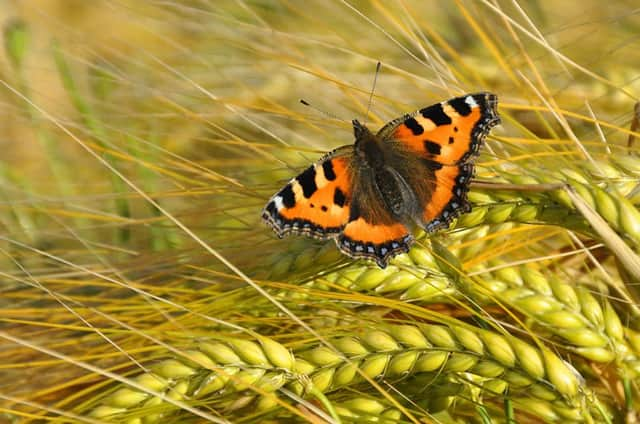Small tortoiseshell butterfly fights back


Populations of the colourful small tortoiseshell have fallen by 78 per cent since the 1970s but this summer it was the most abundant butterfly species found north of the Border.
Results from the 2014 study show a total of 3,560 of the distinctively marked insects were spotted this year.
Advertisement
Hide AdAdvertisement
Hide AdIt is the second year in a row the species has taken top ranking in the annual Big Butterfly Count, organised by the charity Butterfly Conservation.
But sightings actually fell by 29 per cent from the bumper figures seen last year, when an extended season of warm, sunny weather saw numbers triple compared with the washout summer of 2012.
Despite this year’s warm and sunny July, August’s cool, wet conditions had a knock-on effect on the majority of Scotland’s common summer butterflies, curtailing the flight period of some and pushing others into early hibernation.
Across the UK the average number of individual butterflies seen during each count dropped from 23 in 2013 to 15 in 2014 and numbers of most target species were lower than 12 months ago.
The Scottish picture was more balanced, with eight species increasing and 11 decreasing compared with last year.
Richard Fox, surveys manager at Stirling-based wildlife charity Butterfly Conservation, said: “After a good summer in 2013, the big question this year was whether butterflies would continue to recover and build up even greater numbers or slip back again. Thanks to another amazing turnout from the public, we know that the answer is a real mixture. In Scotland, the peacock had a good year in 2013 and this seems to have acted as a springboard for the species, enabling it to increase massively again this summer.
“Others, such as the meadow brown, held their ground in Scotland this year, but sadly many common butterflies appear to have sunk back from last year’s peak in numbers.”
The average abundance of butterflies seen on each count fell by a much smaller amount, from 13 in 2013 to 11 this year.
Advertisement
Hide AdAdvertisement
Hide AdThe biggest increase was for the peacock, which rose by 366 per cent compared to 2013.
Numbers of the large skipper, an orange-coloured butterfly found only in southern parts of Scotland, rose by 330 per cent and the well-known red admiral by 205 per cent. However, common white butterflies fared less well this summer.
The green-veined white was down by 37 per cent and the small white by 46 per cent. Sightings of the brown-coloured ringlet were also down.
Nearly 45,000 people took part in this year’s survey, spotting 560,000 butterflies in the three-week recording period.
While most species had declined compared with last year, most were still well above levels recorded during 2012. Experts say numbers have always fluctuated, but the cause of the most recent decline is not known.
Some suggest climate change has led to the increasing presence in the UK of a parasitic fly commonly found on the continent.